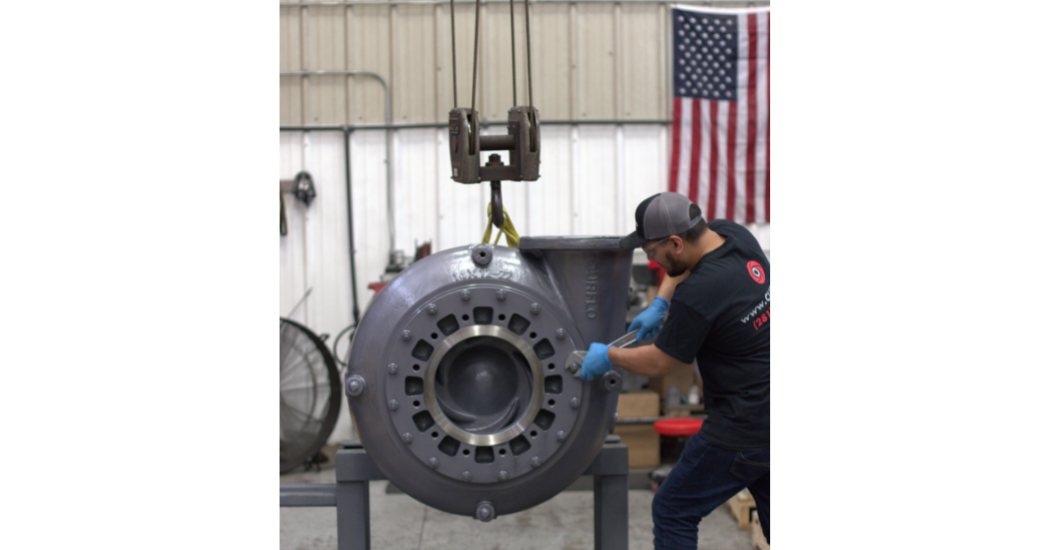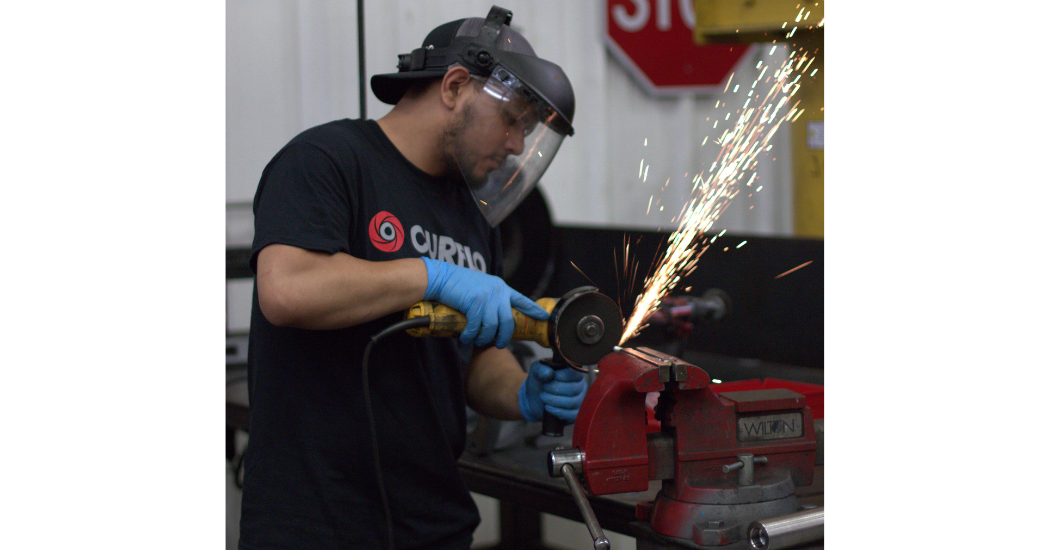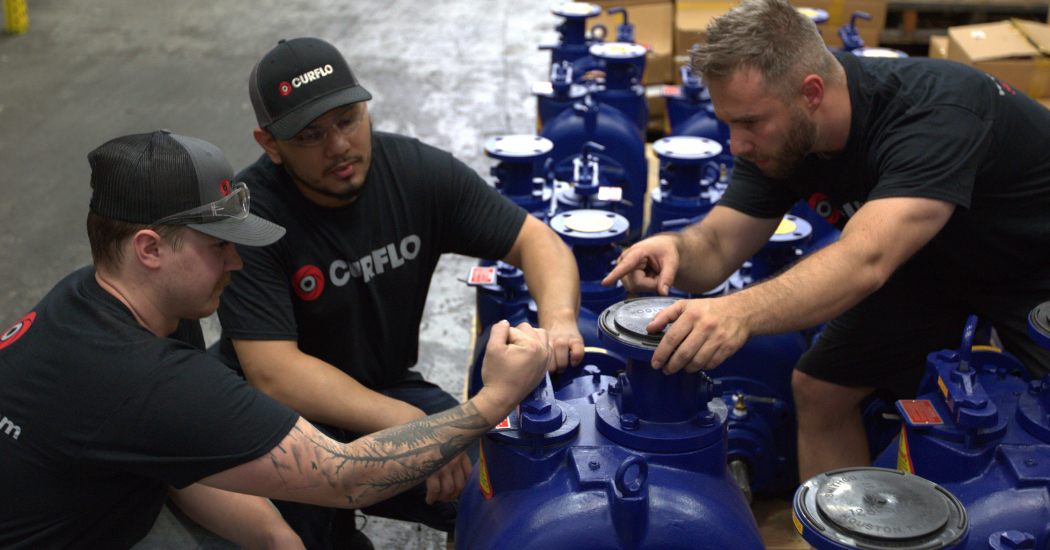During the long global shutdown caused by the 2020 Covid pandemic, staying ahead of the game became the name of the game with regard to manufacturing and distributing pumps and key components. At least that was the case for pump manufacturer, Curflo, and one of its key distributors, Stealth Pump & Supply.
Solving the critical supply chain challenges that resulted from the shutdown required a strategic plan. They needed to study detailed market analyses and have accurate trend forecasting. It also required anticipating that the world would get back to normal, eventually. By throwing into the mix a little bit of risk, trust, bravery, and constant communication between manufacturer and distributor, Curflo and Stealth found a recipe for success that catapulted them into a competitive position for the industry bounce back of 2022.
 “Our plan was mostly risk driven,” explained Curflo’s VP of Operations, Bradley Ritchey. “We weren’t developing new products or doing anything differently. It was a matter of strategic timing. We needed to time the market demand accurately and successfully guess when sales would rebound. We took the risk of believing in our distribution channels and listening to what they were telling us. We tried to get as much market analysis as possible—prospecting about what kinds of materials would sell, and what size pumps to focus on. Then we just took a risk and loaded up. Even though we knew Covid 2020 would put strains on the revenue side, we decided to continue to invest in ourselves and prepare inventory appropriately.”
“Our plan was mostly risk driven,” explained Curflo’s VP of Operations, Bradley Ritchey. “We weren’t developing new products or doing anything differently. It was a matter of strategic timing. We needed to time the market demand accurately and successfully guess when sales would rebound. We took the risk of believing in our distribution channels and listening to what they were telling us. We tried to get as much market analysis as possible—prospecting about what kinds of materials would sell, and what size pumps to focus on. Then we just took a risk and loaded up. Even though we knew Covid 2020 would put strains on the revenue side, we decided to continue to invest in ourselves and prepare inventory appropriately.”
It was a gamble that paid off.
“A lot of our manufacturing competitors sat back and waited,” Ritchey said. “They were cutting inventory while we were stocking the shelves. We did the opposite of everyone else with the hopes of a big bounce back in 2021.”
Inventory can be a tricky thing, especially during times of international chaos, Ritchey explained.
“Industry is experiencing an incredible increase of lead time,” he said. “Our main discussions from Day One revolved around the issue of inventory. It’s important not to have too much or too little. During Covid there were a lot of supply chain lockdowns that accelerated the issues that already existed.”
Manufacturing slowed because demand decreased. That led to a decrease in sales industry wide. In response, many companies cut back on inventory and production. As 2021 became the bounce back year, many companies are still struggling to catch up.
 Curflo, a Houston, Texas-based manufacturer of ANSI pumps and parts, took a risk during the shutdown and was able to maintain inventory throughout 2020 and 2021. Having a distributor like Stealth Pump & Supply, who could get the product to the end users quickly, was a game changer for Curflo.
Curflo, a Houston, Texas-based manufacturer of ANSI pumps and parts, took a risk during the shutdown and was able to maintain inventory throughout 2020 and 2021. Having a distributor like Stealth Pump & Supply, who could get the product to the end users quickly, was a game changer for Curflo.
“Surviving market fluctuations and supply chain issues during something like a pandemic requires a lot of faith and trust in your company and in your partnerships,” said Blake Lisenbe, Chief Operating Officer & Owner of Stealth Pump & Supply, a west-Texas oil and gas industry distributor of industrial equipment. “The partnership between Curflo and Stealth made the world of difference for our customers. Brad had confidence that they had a great product and that the market would eventually come back. I had that same mindset. That helped us to work together strategically and just keep moving forward. A positive mindset can change everything.”
The partnership was not a one-way street. Both the manufacturer and the distributor took risks. Most important, they trusted each other and worked together as a team.
“Curflo stocked up on inventory, but so did we,” Lisenbe said. “The biggest key for Curflo is that they take the time to listen to what we are telling them, and then they take the steps required to make it work. The mistakes that some manufacturers make is focusing only on the manufacturing side and not taking critical input from the distributors. Curflo is great about listening to us, considering what we are telling them and then together we can come up with a plan moving forward to improve the process and understand the market trends. That’s what separates them from the manufacturers who are struggling.”
Throughout the past couple years since the 2020 Covid shutdowns, the ebb and flow of industry has caused challenges for almost every manufacturing company in all industries. The supply chain challenges have caused havoc for all companies. The response to those challenges is what has allowed companies like Curflo to survive the slow times and prepare for the influx of business on the other side.
“The biggest contributing factor holding people up since Covid was the shutting down of manufacturing and how slow everything became,” Lisenbe said. “Companies stopped filling their inventory. Then when things picked up again in 2021, it happened so fast that many manufacturers couldn’t keep up with the demand. It was like flipping a light switch, and then all of a sudden you have all this product that needs to be shipped out. It takes time to restock and fill those shelves again and catch back up. I think that Curflo did a great job of staying ahead of it. Brad and I had multiple meetings during the Covid shutdowns to find solutions to keep up and stay ahead because we knew that it would eventually come back strong, and we would need to be prepared for that. They made the bold decision to pull the trigger and have a lot of equipment on order and in the process of being manufactured while many other companies were tightening their belt loops and didn’t invest in the future or plan for what would be needed as soon as things opened back up again.”
Lessons Learned
Even with the gamble of building inventory without orders during times of inflation, rising raw material costs and supply chain challenges, both Curflo and Stealth learned some lessons about surviving a global shutdown and keeping business on track.
“One of the biggest key factors for Curflo and Stealth was the great communication that we had,” Lisenbe said. “We talk so much that we are able to trust each other. It took a lot of faith on Curflo’s part to believe in what we were telling them. And then we had the confidence that we could move the product. Even during the really slow times, Curflo continued to place orders and had faith that their distribution channels would move the product. They are one of the only companies I deal with who actually had product sitting on the shelf when the orders started coming in again.”
Strategic market forecasting became an essential tool for both the manufacturer and the distributor.
“Yes, there were some cuts, but we never fully stopped production,” Ritchey said. “We continued to manufacture the components. We kept a steady stream of components that were being casted and machined and imported. The whole process continued to run smoothly, and we just never went into a complete shutdown. We also continued to do heavy analysis, especially in 2020. In the third quarter of 2020 we really pulled the trigger and ramped it up. Blake and I spent a lot of time together talking about the market, forecasting, and trying to have a good understanding of when things would fully come back. We slowed down a little, but we never really took our foot off the gas entirely. We knew we needed to keep a steady stream flowing.”
It takes about six months for Curflo to manufacture its products, from the order to the delivery.
“When the process is completely shutdown, it’s hard to reboot,” Ritchey explained. “The companies that did not keep going through 2020 and 2021, are going to have a big disadvantage in 2022 because it takes half a year or more to get things going again. Because we didn’t stop, we are now a good six months ahead of our competition. They are doing the same thing we are, but we just did it a year ago. That gives us an edge.”
The demand for product has skyrocketed quickly—even more so than originally forecasted. That means that the companies with inventory ready to ship have a huge competitive advantage. Lisenbe and Ritchey said they can recommend 10 key takeaways to overcoming supply chain issues in industry.
- Manufacturers should spend time listening to its distributors.
- Perform in-depth market research.
- Develop an understanding of what the future holds.
- Take the time to listen to different points of view about what the market will bear.
- Trust distributors when they tell you how much product they can move.
- Get a game plan and strategy to stay ahead of the market demands.
- Develop key partnerships between manufacturers and distributors.
- Talk through the challenges that arise to find a reasonable solution.
- Work together. It takes both sides of the business to service the industry.
- Take a gamble during slow times to stay ahead of the market.
Overcoming Challenges
Centrifugal pumps are heavily manufactured internationally. The supply chain challenges of getting the equipment delivered to the U.S. has been a major challenge that still exists. Covid forced a spike in container prices and shipping and also presented chaotic logistic challenges.
“Maintaining our process throughout the shutdowns was a key to our success,” Ritchey said. “It was our job to maintain the manufacturing and support our distributors with product so they would be ready to go. Our distributors give us the information of what they think will move. They are talking to the end users, so they also can see the future. We use that data to help make investment decisions. Then we can plan for the long term. We try to stay at least six months ahead of the game. Communications with our distributors helps us better forecast and make more strategic decisions about what the market will bear now and in the future.”
Fluctuating prices continue to present daily challenges, but quality should not falter in the process of getting the products out the door.
“We have lots of conversations about pricing, with regard to inflation, material costs, and shipping costs,” Lisenbe said. “Everything is going up. We were able to come together and structure a plan for pricing for 2022. Also, it’s important to maintain quality. You must keep consistent quality coming through production during a slowdown. When you ramp up again you must take the time to maintain the quality of product.”
Ritchey agreed that companies who are not prepared for an influx of orders could experience a downgrade in quality.
“This often happens when companies ramp up too fast,” he said. “They miss a lot of the little details when trying to move as much product as they can in a short period of time. The pump game is always evolving and moving and changing. One of the issues we experienced was the importance of noticing the trends and responding to them. You may have one class of pump that is not selling much, and then all of a sudden that size pump is selling faster than it can be produced. The key is understanding those market trends and trying to make a plan to prepare for them. This can help to avoid time constraint issues and long lead times.”
Strategic forecasting also becomes a critical component in overcoming these challenges.
 “Our owner is always pushing to keep the constant pressure on,” Ritchey said. “He is always thinking forward. You can’t sit back and wait. At the end of the day, to stay in business you must have revenue. And you can’t have revenue without product. Curflo did a great job of supporting its employees and supporting our distribution. We knew business would come back, so we were in constant communication about actions we could take and how we could prepare ourselves and stay ahead. We had to take the risk together. Many companies did not invest in their inventory and distribution, and for us, that was a game changer.”
“Our owner is always pushing to keep the constant pressure on,” Ritchey said. “He is always thinking forward. You can’t sit back and wait. At the end of the day, to stay in business you must have revenue. And you can’t have revenue without product. Curflo did a great job of supporting its employees and supporting our distribution. We knew business would come back, so we were in constant communication about actions we could take and how we could prepare ourselves and stay ahead. We had to take the risk together. Many companies did not invest in their inventory and distribution, and for us, that was a game changer.”
Both Lisenbe and Ritchey agree that the outlook for 2022 is positive.
“The numbers speak for themselves,” Ritchey said. “The demand is back. People are flying and going back to work, so the natural demand for energy is back.”
During the pandemic, staying ahead of the game was the key. Now, it’s about keeping up with demand in a rapidly evolving climate.
“Curflo has done a much better job than many companies,” Lisenbe said. “As a whole, manufacturing has not been able to keep up with demand. Lead times for components like motors and fittings are moving further and further out. But I’m not seeing that problem with Curflo. Across the board, we are seeing a lot of products moving but the delivery dates change daily. The cost of materials changes daily, the cost of containers coming across the seas is fluctuating. So, most quotes are only good for a couple days. It’s like the Wild West out there. It’s crazy.”
And in an environment like that, stability is everything.
“Our success is a direct result of the communication we have with our distribution,” Ritchey said. “A lot of decisions in manufacturing take some time and go through many channels. Because of the market downturn created by Covid, there is just as speedy a pace of bounce back. It comes back to the simple fact that the companies that are nimble and able to make quick decisions and can act quickly will have a huge advantage. Covid is not going away. It will be another year or two of supply chain issues for all industries.”
And in the end, the partnership between manufacturing and distribution is the ultimate game changer.
“Your distribution needs to understand their industry and be able to see into the future,” Lisenbe said. “Industry always bounces back. Then the manufacturer needs to decide where they want to be when it does bounce back. One of the biggest things we have working for us is that we both took the risk. We both stocked up on inventory. It’s a partnership—a marriage—and both sides need to have skin in the game. We have our feet on the ground and can predict what the market will bear. But the manufacturer needs to trust us. We both took a big gamble and now it’s paying off.”
 Michelle Segrest is an industry reporter with more than three decades of experience as a journalist. She is the president of Navigate Content, Inc., and the host of the Factory of the Future podcast.
Michelle Segrest is an industry reporter with more than three decades of experience as a journalist. She is the president of Navigate Content, Inc., and the host of the Factory of the Future podcast.


Comments